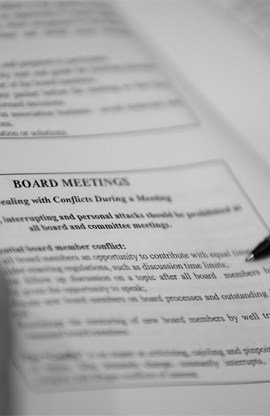By Beth Mulcahy, Esq.
When a homeowner files a bankruptcy (and lists an association as a creditor in the bankruptcy), there is an automatic stay in place, which prohibits the association from proceeding forward with collection against the owner or face strict and costly penalties. The association may proceed forward after the bankruptcy is dismissed, a lift of stay is granted to the association or the bankruptcy is terminated. Therefore, when the associatio receives notice that a homeowner has filed a bankruptcy the file should be clearly flagged as a bankruptcy file, so that no actions are taken in violation of the stay.
There are two types of bankruptcies, Chapter 7 and Chapter 13. The notice of bankruptcy will identify the type of bankruptcy and the date of filing. The master mailing list and bankruptcy schedules will set forth whether the association is a listed creditor in the bankruptcy.
A Chapter 7 Bankruptcy is generally, but not always, a no asset bankruptcy. If the homeowner has no assets, the notice of bankruptcy will state that a creditor should not file a proof of claim unless a notice to do so is received. If the homeowner owes delinquent assessments, the association should file a Notice of Appearance to assure that the association receives all notices from the Court regarding the bankruptcy. Unless the association receives notice to file a Proof of Claim, generally, the association will only need to file a Notice of Appearance and periodically monitor the status of the case.
If the debtor (owner) receives a DISCHARGE of his/her Chapter 7 Bankruptcy, the debtor is no longer personally liable to the association for any pre-petition amounts owed to the association (any amounts owed prior to the date the debtor/owner filed for bankruptcy). The association should adjust the association’s accounting ledger to reflect that the owner is no longer liable for the pre-petition amounts. However, if the debtor is still an owner within the association, the association is still a secured creditor of the debtor; therefore, the association still has a valid lien against the debtor’s lot/unit (note: lien is only valid for 3 years from the date the debt became due and owing). Accordingly, if the debtor sells/refinances his/her lot/unit in the future the association could be paid in full (for the pre and post-petition amounts) through the proceeds.
A Chapter 13 Bankruptcy is called a “wage earners” bankruptcy due to the fact that the party filing has a regular income and has some assets from which to pay creditors. If a homeowner files a Chapter 13, the association should file a Notice of Appearance and a Proof of Claim in the case. The Proof of Claim should include the pre-petition debt and attorney fees incurred and anticipated in the bankruptcy.
In every Chapter 13, the debtor files a proposed plan in whchto pay creditors back the pre-petition debt. Secured claims have priority over unsecured claims and are generally paid in full. As long as the homeowner still owns the property (i.e. has not lost it at a Trustee’s Sale during the term of the bankruptcy), the association is a secured creditor. After the debtor’s plan is approved by the Court, the association will receive payments from the bankruptcy trustee for the amount of its claim (or the amount of the claim approved in the order confirming the plan). Payments received from the trustee should be applied towards pre-bankruptcy debt.
Responsibility for Post-bankruptcy Assessments: A homeowner is responsible for all assessments, late fees and other charges, including bankruptcy related attorneys’ fees after the date of filing. If the homeowner is not staying current on his/her assessments, the association’s attorney should send a letter to the homeowner’s bankruptcy attorney regarding the post-bankruptcy delinquent assessments. However, the association cannot initiate collection or threaten to cut off services, due to a homeowner’s post-bankruptcy delinquent account. The automatic stay precludes such actions.
Lift of Stay: If the owner is not paying post-petition assessments and not responding to post-petition demand letters, the association has the opportunity to file a motion to the Court requesting a relief of stay. This is costly and most debtors will object and the motion may not be granted by the Bankruptcy Court. However, if granted, the bankruptcy stay will not be in effect against the association and the association may proceed forward with collection, including foreclosure. If the owner fails to pay his/her mortgage, the mortgage company will likely file a motion for the lift of bankruptcy stay. If granted, the mortgage company will be able to proceed forward with foreclosure through a Trustee’s Sale.
Date of Filing is the date that triggers the automatic stay and precludes any further collection action against the homeowner for unpaid assessments.
Date of Discharge Chapter 7: The date the Court grants the debtor a personal discharge of all debt owed as of the date filed for bankruptcy protection. Chapter 13: The date the Court grants the debtor a discharge of all debt owed and not paid pursuant to the Bankruptcy Plan, as of the date filed for bankruptcy protection.
Date of Termination or Closing of Case is the date that the bankruptcy case has been closed or terminated and the automatic stay is no longer in effect.
Property Sold by Owner During Bankruptcy Term:
ALL AMOUNTS ARE DUE AND OWING! A payoff should include pre-petition debt and post-petition debt due to the association. It is very important to be sure that when providing a payoff, both pre and post-petition accounting ledgers, if separated, are taken into consideration in which to base the payoff.
Dismissal of Bankruptcy:
In some cases a bankruptcy will be dismissed. This is usually due to the homeowner’s failure to pay fees to the Court, file a plan or fund a plan. When a case is dismissed, it’s as if it were never filed and the association is able to resume collections on the homeowner.
